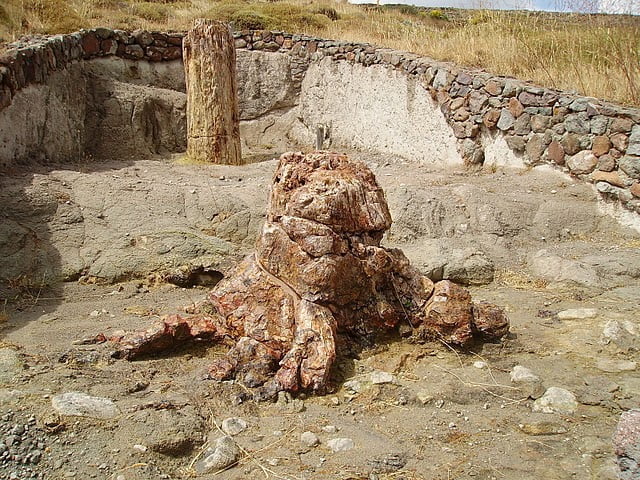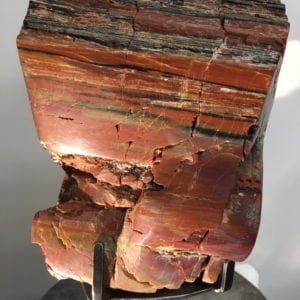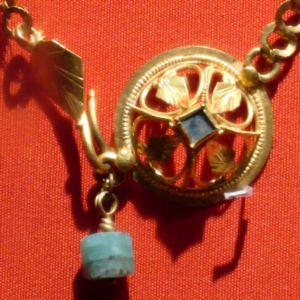Electrifying Petrified Wood Discovery on the Island of Lesbos, Greece
March 20, 2021 by MichaelG
The Greek island of Lesbos is notable for it’s Petrifed Wood forest, a protected national monument. The forest is located on the western portion of the island and was formed from the Late Oligocene to Lower–Middle Miocene and consists of silicified remnants of a sub-tropical forest that going back 20–15 million years ago.
Recent discoveries in the rich Petrified Forest have been electrifying. First was the rare discovery of a spectacular 19.5 meter long log , with accompanying roots, branches, and trees, the only found to date in over 25 years of excavations. Weeks later, the excavators uncovered over 150 more petrified wood logs and petrified wood stumps including conifers, fruit producing trees, sequoia trees, pine, palm, cinnamon and oak trees. The finds were all discovered in the same pit.
The excavation team has been working since 2013 excavating along a 20km stretch of highway and have made 15 major finds, but these all pale to this most recent discovery, which was actually the result of a lucky accident. One the excavators notices a leaf in a stretch of the highway about to get asphalted, and halted the road work.
The park has been designated a UNESCO Global GeoPark. There is an excellent museum well worth visiting. If you visit the park, remember that the removal and transfer of fossilized material is prohibited by law. The forest includes six parks. The fossilized trees include mainly huge sequoias and primitive pine trees in an ecosystem closest to the coniferous forests of North America.
While we haven’t been to Lesbos we do have some of our own spectacular Petrified Wood finds available for sale in our catalog.
Top image is of Petrified Forest on the Island of Lesbos, Greece, by C messier – Own work, CC BY-SA 3.0, https://commons.wikimedia.org/w/index.php?curid=8926168

Petrified Wood near Sigri, Island of Lesbos, Greece. Photo By Rutger2 at nl.wikipedia, CC BY 2.0, https://commons.wikimedia.org/w/index.php?curid=3222318
Petrified Wood, Island of Lesbos, Greece. Photo by Signy – Own work, CC BY-SA 3.0, https://commons.wikimedia.org/w/index.php?curid=11642494


Unstable temperature and relative humidity, different rates of expansion and contraction, salt movement, living plant roots and other factors cause cracking in fossil wood. In order to prevent dirt and contemporary vegetation from accumulating into the cracks, and prevent breakages, solutions of especially prepared consolidants are injected in surface cracks. [Kyriazi, E. and Zouros, N. (2008) ‘Conserving the Lesvos Petrified Forest’, Studies in Conservation 53 (Supplement-1 – Conservation and Access: Contributions to the 2008 IIC Congress), London, p. 141-145] The beautiful rose colours of the silicified fossil wood in this picture are due to the presence of manganese ions. Photo by E.Kyriazi – Own work, CC BY-SA 4.0, https://commons.wikimedia.org/w/index.php?curid=44800562
Written by
MichaelG
You may also interested in:

About Petrified Wood
Petrified wood is a fascinating natural wonder, offering glimpses into the past. Preserving ancient trees in stone, the process of forming petrified wood, known as petrification, occurs when trees are
What Kind Of Minerals and Crystals Can Be Found In Ohio?
Calcite and celestite crystals from Ohio If you live in Ohio and want to get rich finding Emeralds then forget it. Your best bet for that is to move to
Ever Popular Ever Beautiful Rose Quartz
Of all the variety of minerals and crystals, perhaps the most beloved and widely collected is quartz. Named from the old Saxon word querklufterz meaning ‘cross vein ore’, it is
The Petrified Forest National Park in Arizona
In northeastern Arizona lies a region named El Desierto Pintado or The Painted Desert by Spanish explorers. In its midst is a 346 square region that is the Petrified Forest
What Do Bastille Day and Crystallography Have in Common?
July 14, celebrated every year in France as Bastille Day, commemorates the storming and seizure of the notorious medieval armory, fortress, and political prison known as the Bastille. It was
A Bridge to Washington made of Mineral and Perseverence
The river is just about a mile wide at this point. Mud colored waves roll along gently, interrupted occasionally by pleasure craft or a mock riverboat filled with sightseers. I
Roman Era Emerald Mine in the Egyptian Desert
Fifteen miles or so from the Egyptian coastline of the sparkling Red Sea stand a series of crumbling structures. Standing upon an area known in antiquity as “Mons Smaragdus”, these
The Uncertain Future of Afghanistan's Mineral Wealth
Poor Afghanistan. It is the country that never seems to catch a break. Remote, poor, land-locked, and yet highly strategic because of its position as the gateway to India and
Organic Looking Moss Agate Use in Art
Moss agate is an un-banded (and therefore not a true) agate. It is a chalcedony with dendritic inclusions of other, typically green, minerals forming filaments and patterns that are suggestive